Email Marketing 101 For Podcasters
After starting a podcast, getting the right equipment, and submitting it to all the major directories, what’s the next step?
To create great content and grow your subscriber base. That’s where email marketing for podcasters can help you stand out.
Many podcasters focus on iTunes or Spotify subscriber numbers to the exclusion of everything else. This is a mistake because you’re dependent on another organization’s platform for your growth.
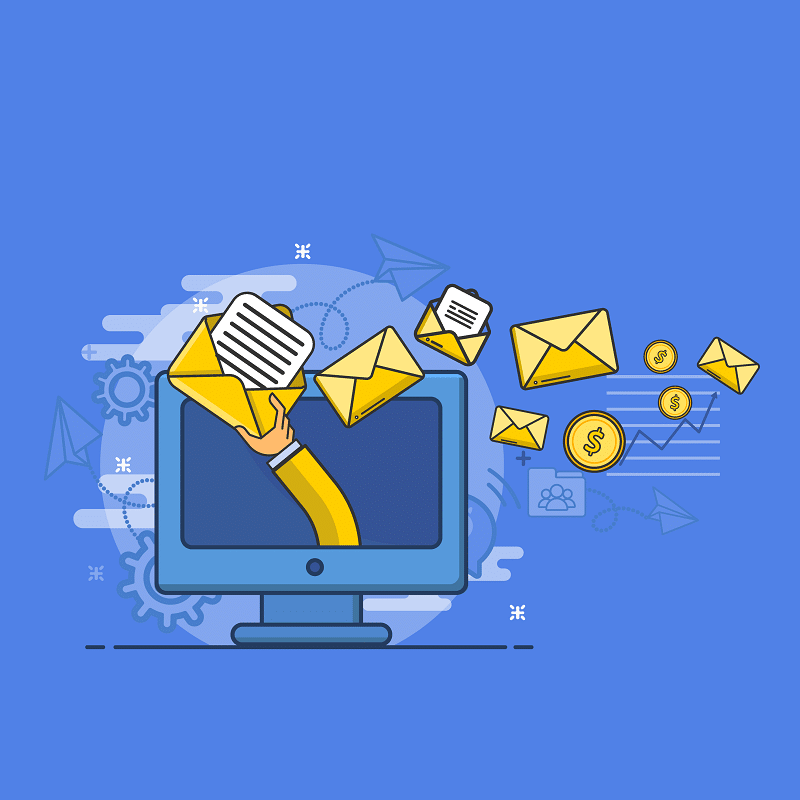
With email marketing, you not only have a direct line of communication to your subscribers, but you can also inform them about more than the latest episode.
In this article, you’ll learn about the power of email marketing, how to grow an email list, and multiple ways to leverage email marketing to create an engaged audience.
Why email marketing is important for podcasters
Many people look at email marketing as extra work so I want to make the case for email marketing.
It’s widely adopted
Every day, there are almost three hundred billion emails sent. That’s more than 30 times the number of humans on the planet.
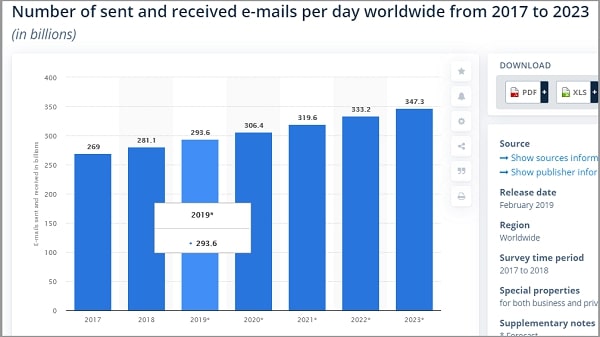
Most businesses use email for regular internal and external communication. 74% of consumers even prefer to get commercial messages through email.
The bottom line is that almost all of your customers and audience not only use email but expect to be contacted through the medium.
It’s effective and measurable
One of the major benefits of email marketing is that everything is measurable. You can track the number of people who’re opening and clicking to the amount of revenue each subscriber is bringing in.
Of course, you’ll need to use a few other tools for proper attribution but. The point is that as long as it originated from your email marketing campaign, you can get granular with your tracking.
Measuring campaigns is nice but it wouldn’t matter if what you’re measuring isn’t effective. Email marketing has been proven to produce results over and over again.
The average CTR of email is 3.39% while that of social media is 1.5%. When email messages are personalized, it can increase revenue by as much as 760%.
These numbers show email marketing for podcasters may be a more effective investment than many other marketing and demand generation channels.
Provides another source of monetization
The final thing to consider when you think of email marketing is its versatility. When you’re hosting your podcast, there are few ways to include a CTA.
An entire episode couldn’t be dedicated to promotion because no one would listen to it and many people would be turned off.
Email marketing allows you to create an entire promotional funnel, include your CTA any number of times, and people won’t flinch. That’s because they’re used to sales and promotional emails (in addition to education and value-based emails).
You can sell your own physical products, digital products, get your sponsors in front of more people, and even promote affiliate products for partners. This can only be done if you have the right tools for the job.
Choosing the right tools
There are dozens if not hundreds of email marketing tools on the market and each one brings something slightly different to the table.
When building an email list, it’s essential to confirm that all collected addresses are valid and functional. Checking the accuracy of these addresses ensures the database remains reliable and minimizes problems like undelivered emails or increased bounce rates.
Keeping the list updated enhances the likelihood of successful delivery and ensures your messages reach the intended audience. This step is fundamental to running effective email marketing campaigns and achieving optimal outcomes.
If you want to pull out all the stops with lead scoring, automation, sales funnels, attribution tracking, etc. there are tools for that.
If you want to send a simple email announcement every time you publish a podcast episode then there are tools for that as well.
The following email marketing tools give you the best of both worlds without breaking the bank.
ActiveCampaign
ActiveCampaign is the software we use at KyLeads. It’s inexpensive and if you’re starting out you can get access to the lowest plan for just $9.99/m.
I’ll be the first to admit that the ActiveCampaign interface can take some getting used to. That’s partly because of all the things it can do.
You’re able to create welcome series that change based on actions people take (behavioral automation segmentation) implement list segmentation, split test emails, create triggers, lead scoring, and everything in-between.
The feature we use the most here is automated behavioral tagging which allows us to create specific email flows based on what people clicked on, the pages they visited, or the emails they’ve opened.
If you’ve used an email marketing service in the past and want something more powerful then ActiveCampaign is a solid choice. If you want something more beginner-friendly then keep reading.
GetResponse
Getresponse has come a long way from its humble beginnings as an autoresponder. Now, it does everything from sending newsletters, webinars, to allowing you to create landing pages.
It has what it refers to as autofunnel. This may be a bit much if you’re a total beginner but is incredibly useful if you have experience. Basically, you’re able to manage every aspect of your marketing campaigns inside GetResponse from creating Facebook ads to collecting payments.
On the email marketing side, you can create advanced automations and manage your subscribers with ease. If you simply want to send newsletters then it has you covered as well. GetResponse is a powerful tool but it can get complicated quickly.
ConvertKit
ConvertKit is a relatively new email marketing service but has been able to achieve a decent level of success. It was built with bloggers and other creators in mind and it shows.
If nothing else, ConvertKit is simple to use and understand. It doesn’t have many of the advanced features of other platforms but if you want to set up simple email marketing series (for example to welcome new subscribers) or send out newsletters then this tool is more than capable.
Strategies for Growing your email list
After choosing an email marketing service, it’s time to grow your email list. Yes, you have to build it from scratch because trying to cheat the system and buy an email list doesn’t work over the long term and can end up being quite expensive.
Let’s look at a few ways to build a list of email subscribers who want to hear from you.
Lead magnets
A lead magnet is something you offer visitors in exchange for their email address or other contact information. A lead magnet can be anything from a book to a cheatsheet or even software.
The best lead magnets are relevant to what someone is interacting with right now. For example, if someone is listening to a podcast episode about affiliate marketing, you don’t offer them an online business cheatsheet, you offer them an affiliate cheatsheet.
There are many ways to get your lead magnets to the right people at the right time such as lightbox or modal forms, slide-in popups, lightbox popups, and more.
Inline forms
Inline forms are list building devices embedded within the content of a page. They’re unique because they don’t interrupt the visitor or otherwise obstruct their ability to interact with the content. At the same time, they capture the most engaged users.
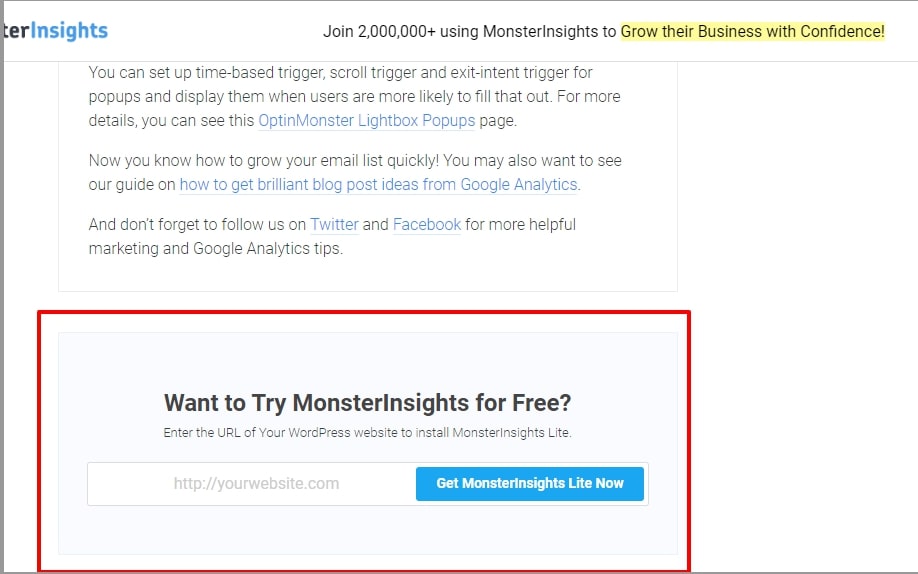
With KyLeads, you’re able to create inline forms and embed them anywhere on the page. It can perform a number of actions such as capture email addresses, survey your visitors, and even direct them to other landing pages.
Slide-ins
Slide-ins are another type of opt-in form that helps you grow your mailing list. Instead of being embedded in your content, it slides in from the bottom right or bottom left of the screen. This is ideal when you don’t want to affect the browsing experience but still need to draw attention to your lead magnet.
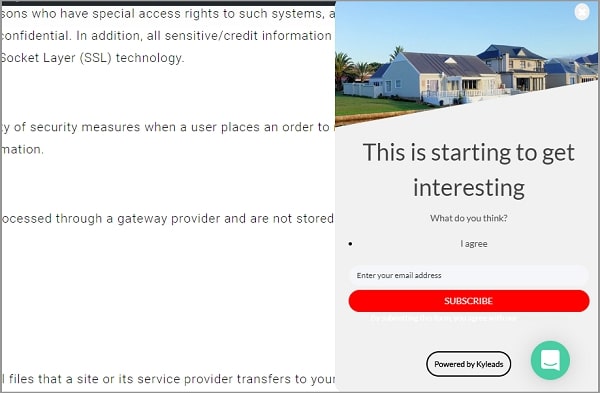
Lightbox popups
The lightbox popup (also known as modal, popup form, etc) is the most common lead capture device. A large number of websites use them because they’re effective but they’re also intrusive.
They appear on top of the page content and obscure it. It won’t leave the screen until the visitor clicks to exit or leaves the page. It can be an effective way to grow your email list but it can also annoy your visitors.
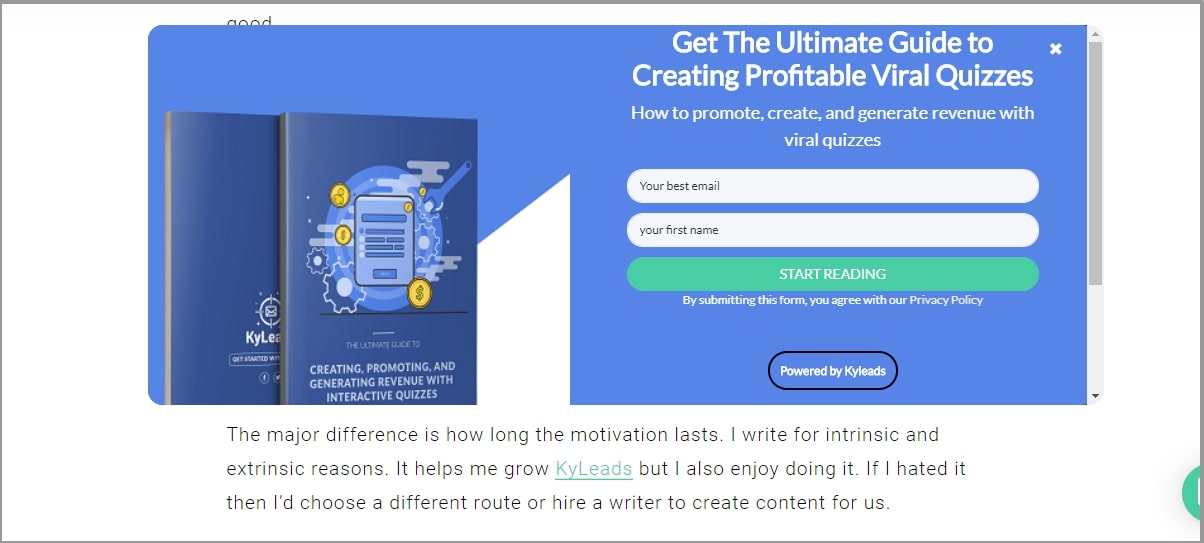
There are more variations of these lead collection tools such as:
- Full-screen takeovers
- Floating bars
- Sidebar forms
- Wheel of fortune
Use KyLeads to Build Engaging Popups & Quizzes
Grow your mailing list faster with the list building tools available in KyLeads. Start your free trial and see the results for youself.
Free course
A free course is a powerful way to grow your subscriber base, introduce them to your brand, and guarantee high engagement metrics.
You can do an email only course where everything is self-contained or you can opt for a video course that’s delivered via email.
It should be at least 5 days long but generally shouldn’t exceed 30 days. In the first few days (if it’s longer than seven days) send an email every day. Afterward, send an email every other day until the course ends.
Each message should build on the last and deliver a specific outcome. If there’s no clear outcome then people won’t sign up.
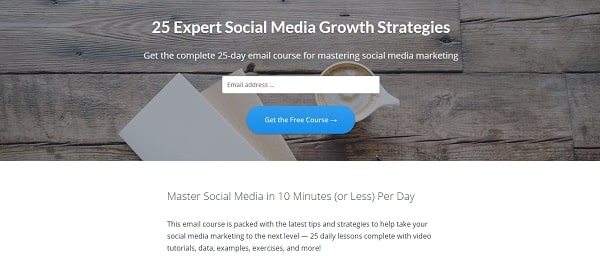
Interactive quiz
Interactive quizzes are a largely untapped way to grow your audience. Many people look at them as a gimmick but when used properly, they routinely get over 30% conversion rates.
The key is creating a quiz your people care about. If you’re a fitness podcaster then a quiz about body type could work well. A quiz about spirit animals is unlikely to move the needle much.

They work best as one of the main lead magnets on your website. The more people that see and interact with it, the more opportunities you have to improve it over time.
Custom landing pages
Your custom landing pages could offer almost anything to subscribers. Think of them as dedicated pages for your lead magnets. To get people to these pages, which tend to be harder to find on a website, include a CTA at the end of every podcast episode.
Every time a new listener comes around, they’ll hear your CTA and a few of them will check out the page. Some listeners will hear it multiple times and finally check it out.
Since you’ll be sharing it so often, ensure it’s something that can appeal to the majority of your audience. Or, you can use an opt-in survey to find out more about them before presenting an offer. This is a more advanced option so if you’re not sure how to do that, opt for a quiz.
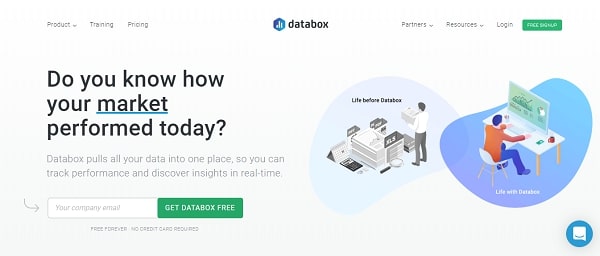
Once you’ve gotten one or more of these set up, it’s time to start driving traffic to them. You can do that through paid ads, blogging and content marketing, or even mentioning it on your podcast. Be sure to choose the right landing page software because the wrong tool does more harm than good.
Types of emails to send subscribers
After you’ve started to see the results of your effort in the form of new subscribers signing up on a daily basis, start sending emails. In this section, we’ll look at three of the most effective types of emails you to use.
There are many more email types but these ones will serve you well until you’re ready for more advanced strategies.
Regular newsletter
A regular newsletter is the backbone of an effective podcast email marketing strategy. Unlike ecommerce stores, your subscribers don’t want a constant stream of offers, discounts, and launches.
Choose a regular interval between newsletters. It could be a monthly digest of all your best content, a weekly message that announces your newest podcast episode, or an email sent out multiple times a week.
Whatever frequency you choose, make sure it’s something that you can keep up with.
What kind of content works well in a newsletter?
Of course, you want to promote your podcast episodes to your mailing list but that’s only scratching the surface. It’s called a newsletter for a reason, share interesting news which can include:
- Products you’re working on
- Initiatives you’re launching
- Partnerships or upcoming episodes you’re excited about
- Blog posts you’ve created
- News from your industry (with your own spin or commentary)
The most important thing is to understand what your audience would want to see. At the same time, none of the newsletters should be overly promotional. Save that for dedicated launches. Don’t go too far off-brand or off-topic and you’ll be fine.
Product launch
Product launches are involved events and can have many moving pieces. Some launches can include JV partners, managers, and an entire team operating behind the scenes and email is a core aspect of that.
If you’re launching a product for the first time, all of those aspects may not be necessary. Instead, think about how other brands build anticipation for a product that’s about to be launched.
They send you messages that hint at it, create promotional material like a trailer or a blog post, social media updates, etc. and finally reveal the product. They don’t’ stop there, all of their communications over the course of a few days are centered on the product and why it should matter to you.
This strategy can be used for almost any product such as
- Courses
- Physical goods
- Software
- Books
- Consulting
If you’ve implemented list segmentation then you can create specific products for each segment or position the same product differently for each segment. This will help boost your conversion rate without too much extra effort.
While I’ll always encourage you to make more offers, I don’t encourage you to make your email communication one big sales pitch. People will unsubscribe as quickly as they subscribe.
Listener surveys
The more surveys you do the better your content will be. Over time, as your show grows, there will be a broader group of people listening to what you put out.
If, in the beginning, it was only hardcore marketers that listened, that may change to tech founders and small business owners. The topics and guests they’ll find appealing may be slightly different from the topics and guests your original audience appreciated.
You won’t understand that unless you run regular listener surveys. These are short surveys that ask what your listener does (occupation) and what kind of content and guests they’re interested in.
These surveys will serve as your compass. When you send them out regularly, you’ll have no doubts about the direction you need to go in in order to keep growing your audience. Aim for one survey every quarter.
Conclusion
Email marketing for podcasters is an important part of your growth strategy. With it, you have a direct line of communication with your listeners – no more gatekeepers.
There are many moving pieces that we’ve touched on in this guide.
The first step is to create a lead magnet and a way to get it in front of people. After that, send regular newsletters to keep them engaged, product launches to bring in the revenue, and listener surveys to create content they care about.
Podcast email marketing is one of the most important things you can do so take it seriously and watch your podcast grow faster than ever.
Copyright 2018 - 2020, KyLeads. All rights reserved.
